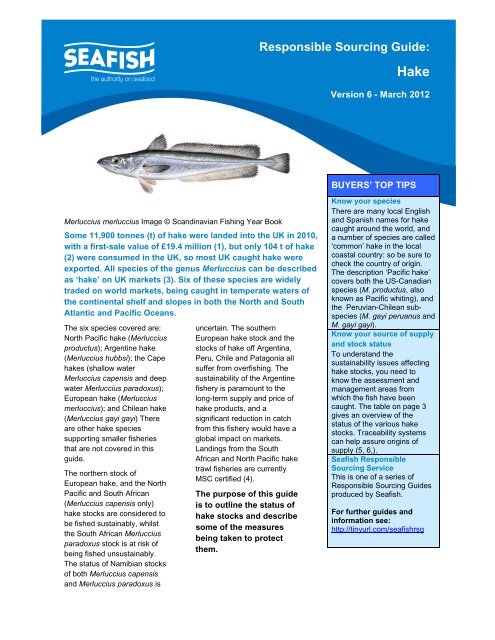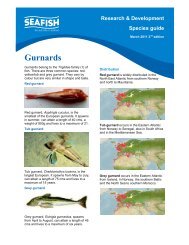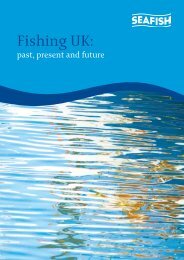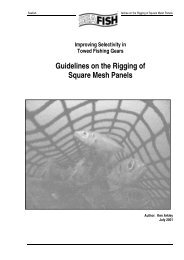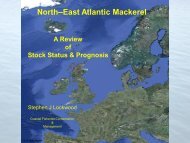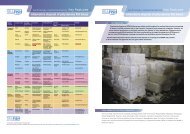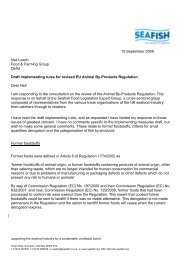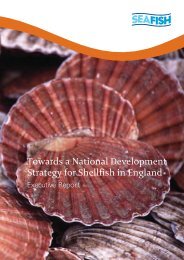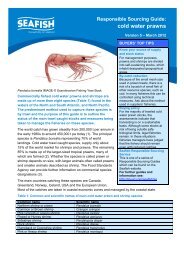Hake 2012 - Seafish
Hake 2012 - Seafish
Hake 2012 - Seafish
Create successful ePaper yourself
Turn your PDF publications into a flip-book with our unique Google optimized e-Paper software.
Responsible Sourcing Guide:<br />
<strong>Hake</strong><br />
Version 6 - March <strong>2012</strong><br />
BUYERS’ TOP TIPS<br />
Merluccius merluccius Image © Scandinavian Fishing Year Book<br />
Some 11,900 tonnes (t) of hake were landed into the UK in 2010,<br />
with a first-sale value of £19.4 million (1), but only 104 t of hake<br />
(2) were consumed in the UK, so most UK caught hake were<br />
exported. All species of the genus Merluccius can be described<br />
as ‘hake’ on UK markets (3). Six of these species are widely<br />
traded on world markets, being caught in temperate waters of<br />
the continental shelf and slopes in both the North and South<br />
Atlantic and Pacific Oceans.<br />
The six species covered are:<br />
North Pacific hake (Merluccius<br />
productus); Argentine hake<br />
(Merluccius hubbsi); the Cape<br />
hakes (shallow water<br />
Merluccius capensis and deep<br />
water Merluccius paradoxus);<br />
European hake (Merluccius<br />
merluccius); and Chilean hake<br />
(Merluccius gayi gayi) There<br />
are other hake species<br />
supporting smaller fisheries<br />
that are not covered in this<br />
guide.<br />
The northern stock of<br />
European hake, and the North<br />
Pacific and South African<br />
(Merluccius capensis only)<br />
hake stocks are considered to<br />
be fished sustainably, whilst<br />
the South African Merluccius<br />
paradoxus stock is at risk of<br />
being fished unsustainably.<br />
The status of Namibian stocks<br />
of both Merluccius capensis<br />
and Merluccius paradoxus is<br />
uncertain. The southern<br />
European hake stock and the<br />
stocks of hake off Argentina,<br />
Peru, Chile and Patagonia all<br />
suffer from overfishing. The<br />
sustainability of the Argentine<br />
fishery is paramount to the<br />
long-term supply and price of<br />
hake products, and a<br />
significant reduction in catch<br />
from this fishery would have a<br />
global impact on markets.<br />
Landings from the South<br />
African and North Pacific hake<br />
trawl fisheries are currently<br />
MSC certified (4).<br />
The purpose of this guide<br />
is to outline the status of<br />
hake stocks and describe<br />
some of the measures<br />
being taken to protect<br />
them.<br />
Know your species<br />
There are many local English<br />
and Spanish names for hake<br />
caught around the world, and<br />
a number of species are called<br />
‘common’ hake in the local<br />
coastal country: so be sure to<br />
check the country of origin.<br />
The description ‘Pacific hake’<br />
covers both the US-Canadian<br />
species (M. productus, also<br />
known as Pacific whiting), and<br />
the Peruvian-Chilean subspecies<br />
(M. gayi peruanus and<br />
M. gayi gayi).<br />
Know your source of supply<br />
and stock status<br />
To understand the<br />
sustainability issues affecting<br />
hake stocks, you need to<br />
know the assessment and<br />
management areas from<br />
which the fish have been<br />
caught. The table on page 3<br />
gives an overview of the<br />
status of the various hake<br />
stocks. Traceability systems<br />
can help assure origins of<br />
supply (5, 6,).<br />
<strong>Seafish</strong> Responsible<br />
Sourcing Service<br />
This is one of a series of<br />
Responsible Sourcing Guides<br />
produced by <strong>Seafish</strong>.<br />
For further guides and<br />
information see:<br />
http://tinyurl.com/seafishrsg
2 Responsible Sourcing Guide: <strong>Hake</strong>. Version 6 – March <strong>2012</strong><br />
Status of hake stocks March <strong>2012</strong><br />
Biology<br />
<strong>Hake</strong> feed mainly on fish and squid, and may also<br />
feed on smaller hake, which is important in their<br />
stock dynamics. They tend to be slow-growing<br />
and late maturing, which makes them prone to<br />
overfishing. Most hake species show large vertical<br />
movements from near the sea bed, where they<br />
spend the day, into mid and surface waters at<br />
night to feed. <strong>Hake</strong> also show substantial offshore<br />
and along-shore migrations, a characteristic that<br />
is reflected in the large areas used for stock<br />
assessment and management (7).<br />
Fisheries and fishing methods<br />
Most hake are taken by bottom trawling, although<br />
pelagic trawls are also used in some areas. There<br />
are also a number of line and gill-net fisheries that<br />
target larger hake, especially in areas of rough<br />
(untrawlable) ground in the UK, Spain, Namibian<br />
and South African fisheries.<br />
Research<br />
Research on European hake is conducted by a<br />
number of European fisheries institutes under the<br />
auspices of ICES. Specific topics funded under<br />
recovery plans include improving mesh selectivity<br />
in trawls to conserve juvenile fish, and the identity<br />
and characteristics of the northern and southern<br />
stocks.<br />
The results of research on hake in South Africa<br />
and Namibia quickly feed through to management<br />
action supported by the industry in both countries.<br />
The Benguela Current Large Marine Ecosystem<br />
Programme is a multinational, ecosystem-based<br />
research initiative. There is also collaborative<br />
research with overseas institutes, notably<br />
Norway’s Institute of Marine Research through the<br />
Nansen Programme.<br />
Much is known about the Argentine hake and its<br />
fishery, with information being provided by a<br />
vessel monitoring system and a small,<br />
intermittent, observer programme. INIDEP<br />
operates a number of research vessels within the<br />
Argentine Exclusive Economic Zone (EEZ).<br />
Both the USA and Canada have substantial<br />
research programmes on North Pacific hake that<br />
cover stock assessment, biology, distribution,<br />
environmental change impacts, fisheries impacts,<br />
and approaches to conservation of non-target<br />
species. This information is used to provide<br />
scientific advice upon which Canadian and US<br />
authorities develop joint fishery management<br />
plans under an international agreement (8).<br />
Assessment<br />
Most assessments of hake stocks rely on<br />
commercial catch and fishing effort data, often<br />
supported by fishery-independent methods such<br />
as research vessel trawl and acoustic surveys<br />
(using echo sounders). The methods used to<br />
assess hake stocks vary by region and depend on<br />
data availability. It can be difficult to age hake<br />
accurately, which detracts from the robustness of<br />
stock estimates in several hake stocks.<br />
Where sufficient data on the age or length<br />
structure and biological characteristics of<br />
commercial catches are available, such as in the<br />
European, Argentine and Chilean stocks, it is<br />
possible to undertake an analytical assessment<br />
(known as a virtual population analysis) that<br />
models the age structure of the stock, spawning<br />
stock biomass (SSB) and other population<br />
variables, which can be used to evaluate the<br />
effects of exploitation on the stock.<br />
Production models may also be used to estimate<br />
the response of a stock to fishing and how much<br />
of the stock may be harvested without depleting<br />
its spawning potential. In their most basic form,<br />
they only require catch and fishing effort<br />
information, but information on age or length<br />
structures can be incorporated. This is the<br />
preferred approach for the South African hake
3 Responsible Sourcing Guide: <strong>Hake</strong>. Version 6 – March <strong>2012</strong><br />
stocks. Until recently, a single combined stock<br />
assessment was conducted for the South African<br />
hakes (M. capensis and M.paradoxus). In<br />
response to conditions set on the MSC<br />
certification of the trawl fishery, each species is<br />
now assessed separately, using commercial catch<br />
data in an age-structured production model,<br />
supported by biological sampling of the catch at<br />
sea and onshore and acoustic surveys. The<br />
assessment of the Namibian stocks has been<br />
conducted along similar lines, using agestructured<br />
production models with commercial<br />
catch data.<br />
Maximum Sustainable Yield (MSY) and the<br />
precautionary approach<br />
Current ICES advice on fish stocks is described in<br />
terms of MSY and the precautionary approach.<br />
MSY relates to optimising yield, the precautionary<br />
approach to avoiding stock depletion.<br />
MSY means fishing at levels that catch the<br />
maximum proportion of a fish stock that can safely<br />
be removed on a continuous basis while, at the<br />
same time, maintaining its capacity to produce<br />
sustainable returns in the long term.<br />
The ICES MSY approach (9) is based on a<br />
strategy whereby catch rates are fixed, enabling<br />
fish stocks to reproduce so that exploitation can<br />
occur in sustainable economic, environmental and<br />
social conditions. The EU has a plan for transition<br />
to MSY in four steps from 2011-15. ICES advice<br />
takes this into account (10). However, in the shortterm,<br />
<strong>Seafish</strong> has classified fish stocks into six<br />
categories under the twin MSY/precautionary<br />
approach.<br />
Categories 1 to 3 will result in a recommendation<br />
for catches consistent with fishing levels which<br />
would result in MSY. For some stocks the MSY<br />
reference points are not defined. In these cases,<br />
catches are defined by the precautionary<br />
approach. Many hake stocks have a management<br />
plan agreed between the parties exploiting the<br />
stock, and scientific advice is given that is<br />
compatible with the plan, although not all plans<br />
are in line with the precautionary approach.<br />
Categories 4 and 5 will result in advice to rebuild<br />
stocks through reducing catches or other<br />
measures.<br />
<strong>Seafish</strong> categories<br />
Table 1: SEAFISH MSY / PRECAUTIONARY<br />
APPROACH CATEGORIES; see table 2 & Fig 1<br />
1. Inside safe biological limits and fished at<br />
MSY. When a stock is of a sufficient size to<br />
reproduce and support a commercial fishery, and<br />
is also fished at MSY.<br />
2. Inside safe biological limits but fished below<br />
MSY. Stock is of a sufficient size to reproduce and<br />
support a commercial fishery, but not fished at<br />
MSY. Fishing could be increased to achieve MSY.<br />
3. Inside safe biological limits but fished<br />
above MSY. When a stock is of a sufficient size to<br />
reproduce and support a commercial fishery, but<br />
corrective action is required to reduce fishing to<br />
levels that are consistent with MSY (F MSY ).<br />
4. Stocks at risk of being outside safe<br />
biological limits and below the biomass action<br />
point B MSY-trigger There is concern that the stock<br />
needs to be rebuilt and fishing mortality<br />
(proportion of the stock captured each year) is<br />
reduced to allow the stock to rebuild. In most<br />
cases, B MSY-trigger is set at the precautionary<br />
biomass reference level.<br />
5. Stock outside safe biological limits. The<br />
stock is in a condition where there is concern that<br />
reproduction may be impaired. Action should be<br />
taken appropriate to each stock to further reduce<br />
fishing mortality and encourage stock rebuilding.<br />
6. Reference points not defined. Where<br />
precautionary or MSY reference points are not<br />
defined or could not be assessed against. There<br />
may be indications that the stock is in good or<br />
poor condition which are described in Table 2.<br />
.
4 Responsible Sourcing Guide: <strong>Hake</strong>. Version 6 – March <strong>2012</strong><br />
Management<br />
Stock (colour<br />
coded to map)<br />
Agreed<br />
TAC <strong>2012</strong><br />
(t)<br />
Advis’y<br />
TAC <strong>2012</strong><br />
(t)<br />
Scientific advice and management<br />
Category 1-3. Inside safe biological limits<br />
North Pacific hake<br />
(Pacific whiting:<br />
Merluccius<br />
pruductus)<br />
393,751<br />
(2011)<br />
757,738<br />
(2011)<br />
The latest assessment in 2011 indicated a stock that is<br />
abundant and not overfished (8,11). The 2008 year class is<br />
estimated, with some uncertainty, to be very large, indicating<br />
good prospects for the fishery. Fishing mortality is below the<br />
target level. There are measures to reduce by-catch of other<br />
species. One MSC certified fishery (4).<br />
South African<br />
shallow water<br />
cape hake (M.<br />
capensis)<br />
European hake,<br />
(Merluccius<br />
merluccius)<br />
northern stock:<br />
ICES Division IIIa,<br />
Subareas IV, VI, and<br />
VII, and Divisions<br />
VIIIa,b,d.<br />
28,869 28,869 South African cape hake are assessed as two separate stocks.<br />
Spawning Stock Biomass (SSB) of M. capensis has been well<br />
above B MSY-trigger for 30 years (12). This indicates a healthy<br />
population that is not overfished. The TACs are set using an<br />
operational management plan that uses time series of both<br />
commercial and survey catch per effort data to forecast on<br />
future catches. One MSC certified fishery (4).<br />
55,105 (13)<br />
(13),<br />
51,900<br />
All EU<br />
waters<br />
combine<br />
d<br />
A new length-based assessment method and extension of the<br />
modelled time period back to 1978 has improved the quality of<br />
the assessment and reduced uncertainty in estimates of SSB<br />
and fishing mortality (10). There have recently been several<br />
high recruitments and SSB has increased since 1998 and is<br />
estimated to be record high in 2011. Though fishing mortality<br />
has been decreasing in recent years, it is still above F MSY . A<br />
recovery plan agreed by the EU in 2004 (14) is scheduled to<br />
be replaced by a long-term management plan (15) aiming<br />
towards MSY. ICES’ advice is given on the basis of the<br />
transition towards the MSY framework.<br />
Cat 4. Stocks at risk of being outside safe biological limits and below biomass action point B MSY-trigger<br />
South African<br />
cape hake<br />
Deep-water<br />
(Merluccius<br />
paradoxus)<br />
115,580 115,580 The SSB of M. paradoxus has improved since 2007, but was<br />
still below B MSY-trigger in 2011. An Operational Management<br />
Plan (see M. capensis) is in place to allow the recovery over<br />
20 years (12). One MSC certified fishery (4).
5 Responsible Sourcing Guide: <strong>Hake</strong>. Version 6 – March <strong>2012</strong><br />
Management<br />
Stock (colour<br />
coded to map)<br />
Agreed<br />
TAC <strong>2012</strong><br />
(t)<br />
Advis’y<br />
TAC <strong>2012</strong><br />
(t)<br />
Scientific advice and management<br />
Category 5. Stock outside safe biological limits.<br />
Argentine hake<br />
Merluccius hubbsi<br />
Northern stock,<br />
North of 41 o S<br />
Argentine hake<br />
Merluccius hubbsi<br />
southern stock<br />
South of 41 o S<br />
Preuvian hake<br />
Merluccius gayi<br />
peruanus<br />
Chilean hake<br />
Merluccius gayi<br />
gayi<br />
Patagonia<br />
Merluccius<br />
australis<br />
60,000 40,000 Spawning Stock Biomass (SSB) has been below the safe<br />
biological limit since 1998 and shows no signs of improvement,<br />
and fishing mortality in 2010 was more than twice the target for<br />
recovery. The catch recommendation is intended to restore<br />
SSB levels, but TACs are set higher that advised and there is<br />
substantial mis-reporting (16).<br />
273,000 238,000 SSB has been below the safe biological limit since 2008 and<br />
fishing mortality is above the target for recovery. Although the<br />
stock is considered to be in poor condition, TACs have been<br />
set in excess of advice in recent years (16).<br />
40,000<br />
(2011)<br />
40,000<br />
(2011)<br />
SSB has recently recovered to around safe biological limits,<br />
but the current fishing mortality is 3 times the target (16).<br />
45,000 33,000 The current stock abundance is slowly recovering but SSB has<br />
been outside safe biological limits since 2004. Although the set<br />
TACs have been above the advised TACs in recent years, the<br />
actual catches have been lower and fishing mortality is below<br />
the target. Technical measures to protect juvenile fish and<br />
closures for stock recovery have been introduced. Industry has<br />
established a protocol for responsible fishing (16).<br />
23,000 22,000 The stock has declined over the past 10 years to its lowest<br />
recorded level, but estimated to be just inside safe biological<br />
limits. Fishing mortality has been above the recommended<br />
level for 9 years (16).<br />
Category 6. Reference points not defined<br />
Namibian cape<br />
hakes (Merluccius<br />
paradoxus &<br />
Merluccius<br />
capensis)<br />
European hake<br />
(Merluccius<br />
merluccius)<br />
Southern stock<br />
ICES division<br />
VIIIc, IX and X<br />
European hake<br />
Mediterranean<br />
145,000 The status of the Namibian stock is uncertain. Stock status<br />
reports have not been published since 2004 and produced<br />
conflicting results (16).<br />
19,373<br />
12,299<br />
(13)<br />
29,841<br />
(FAO 2009)<br />
14,300<br />
Included<br />
in EU<br />
total<br />
No TAC<br />
advised<br />
Recruitment has been high since 2005 and SSB has increased<br />
consistently since 1998, but its status relative to any potential<br />
biomass reference points is unknown. Fishing mortality has<br />
been stable over the last decade and is well above F MSY (10).<br />
A recovery plan agreed by EU in 2005 (15) has not been<br />
evaluated by ICES, which provides advice on the basis of a<br />
transition to the MSY approach, on the assumption that SSB in<br />
<strong>2012</strong> will be above any potential candidate for B MSY-trigger .<br />
No assessment
6 Responsible Sourcing Guide: <strong>Hake</strong>. Version 6 – March <strong>2012</strong><br />
Figure 1: Worldwide distribution for the main hake stocks (colour keyed to tables 1 and 2)<br />
Key<br />
Stock status<br />
Inside safe<br />
biological<br />
limits<br />
At risk of being<br />
outside safe<br />
biological<br />
limits<br />
Outside safe<br />
biological<br />
limits<br />
Reference<br />
points not<br />
defined<br />
Organisation key<br />
ICES: The International Council for Exploration of the Sea. Responsible for providing scientific advice for<br />
North East Atlantic fishery management.<br />
EU: The European Union manages fisheries within the European Exclusive Economic Zone.<br />
MSC: The Marine Stewardship Council is an independent nonprofit organisation that promotes responsible<br />
fishing practices.<br />
DEAT: Dept of Environment and Tourism, South African Government.<br />
MFMR: Namibian Ministry of Fisheries and Marine Resources.<br />
INIDEP: Instituto Nacional de Investigación y Desarrollo Pesquero, Argentine government marine research<br />
institute.<br />
SAGPyA: (National Institute for Fishery Research and Development) Agriculture, Livestock, Fishing and<br />
Food Secretary, Argentine.<br />
DFO: Dept of Fisheries and Oceans, Canadian Government.<br />
NMFS: National Marine Fisheries Service, US Government.<br />
PFMC: Pacific Fishery Management Council, US Fisheries management body.<br />
Subsecretaría de Pesca, Gobierno de Chile.<br />
USDA: United States Department of Agriculture, USA.
7 Responsible Sourcing Guide: <strong>Hake</strong>. Version 6 – March <strong>2012</strong><br />
Management and conservation measures<br />
<strong>Hake</strong> is prone to overfishing<br />
due to its slow growth and the<br />
relatively old age at which<br />
females reach maturity. The<br />
key management issues are:<br />
Capture of juveniles<br />
It is important to control<br />
mortality of the juvenile fish to<br />
enable them to contribute<br />
more to reproduction and<br />
yields. An EU emergency plan<br />
in 2001/2 addressed<br />
excessive mortality of small<br />
hake in the northern European<br />
stock, using mesh size<br />
restrictions in specific areas<br />
off SW Ireland and in the Bay<br />
of Biscay (see Fig. 2). Fishing<br />
mortality on small hake has<br />
remained low since 2001.<br />
There are often cultural and<br />
economic difficulties in<br />
reducing catches of small<br />
hake – there are strong<br />
markets in some countries and<br />
hake constitutes an important<br />
part of the inshore vessels’<br />
catch.<br />
Excessive fishing effort<br />
It is difficult to avoid further<br />
depleting already low stocks in<br />
multi-species fisheries, but<br />
recovery plans for both<br />
northern and southern<br />
European hake stocks include<br />
catch and fishing effort<br />
controls. However, to maintain<br />
relatively stable catches, the<br />
EU will not change the TAC by<br />
more than +/- 15% in any one<br />
year. As a result, catches may<br />
be higher than recommended<br />
by scientists. The TAC for the<br />
Argentine hake stock is<br />
typically set 30% higher than<br />
INIDEP advises.<br />
Illegal landings<br />
TACs have been exceeded in<br />
many hake fisheries. Catches<br />
in the South American hake<br />
fisheries often exceed the<br />
TAC by as much as 30% and,<br />
apart from in 2007-2009,<br />
annual landings of Northern<br />
European hake have<br />
exceeded the TAC since 2001<br />
(10).<br />
Management control<br />
Better management of hake<br />
fisheries allows the stocks to<br />
return to a productive state.<br />
The northern European hake<br />
stock has recovered since the<br />
introduction of measures in<br />
2001, and the North Pacific<br />
hake fishery has also<br />
recovered from a low point in<br />
2004. The success of these<br />
recovery plans requires<br />
determination by<br />
Governments, plus industry<br />
acceptance and compliance.<br />
There are the beginnings of<br />
both these elements in the<br />
South American fisheries, but<br />
these stocks remain at low<br />
levels. Landings of Chilean<br />
hake have shown a significant<br />
decline, from a peak of over<br />
100,000 t in 1999-2003 to<br />
42,000 t in 2010 (16). There<br />
has been concern about the<br />
fishery’s sustainability, but<br />
management has been<br />
improving.<br />
Environmental impacts<br />
Most hake are taken by<br />
bottom trawling, which can<br />
cause damage to the sea bed<br />
and seabed-living organisms.<br />
However, the patchy<br />
distribution of fishing effort,<br />
and soft bottom sediments<br />
favoured by hake, limit this<br />
type of ecosystem effect.<br />
Both trawl and long-line<br />
fisheries can affect birds, but<br />
well managed fisheries<br />
implement mitigation<br />
measures, as can be seen in<br />
the South African trawl<br />
fisheries. Conservation<br />
protection for non-fish by<br />
catch in the Chilean hake<br />
fishery uses closed areas<br />
(seabed-living habitats) and<br />
technical measures (seabirds).<br />
Figure 2: EU restricted area to<br />
conserve hake by mesh size<br />
and limiting fishing effort (15).
8 Responsible Sourcing Guide: <strong>Hake</strong>. Version 6 – March <strong>2012</strong><br />
Product characteristics and seasonal cycles<br />
The types of product vary by hake species and country of<br />
origin. Most fisheries produce a mix of fresh and frozen<br />
products. The fresh material is mainly for local consumption or<br />
on-shore processing, although some line-caught fish are chilled<br />
and air freighted as high value product. Fresh products include<br />
gutted, headed and gutted (H&G), and fillets. Most<br />
internationally traded product is partially processed, and then<br />
frozen at sea, and further processed ashore either in the<br />
country of landing or at final destination. Processed and frozen<br />
at sea product includes H&G and fillets and is frequently the<br />
highest quality available. <strong>Hake</strong> may breed throughout most of<br />
the year. The spawning in different sea areas is shown below.<br />
European hake (8)<br />
Argentine hake (21)<br />
Chilean hake (21)<br />
Pacific hake (13)<br />
Cape hakes (8)<br />
Namibia M. capensis<br />
South Africa<br />
Supply chain standards<br />
J F M A M J J A S O N D<br />
Spawning<br />
Peak spawning<br />
Responsible practice in the chilled and frozen supply chain<br />
depends on correct catching, gutting, washing, chilling or<br />
freezing, processing and handling practices throughout the<br />
chain. There are standards which cover these aspects from<br />
capture to retailer:<br />
• <strong>Seafish</strong> Responsible Fishing Scheme. Sets best practice<br />
standards for fishing vessels, based on British Standards<br />
Institution specifications (BSi: PAS 72:2006) (17); and<br />
• British Retail Consortium (BRC) Global Standard and<br />
Safe & Local Supplier Approval (SALSA) certification.<br />
Designed to raise standards in the seafood processing and<br />
wholesaling sectors.<br />
REFERENCES<br />
1.www.marinemanagement.org.uk/fisheries<br />
/statistics/documents/ukseafish/2010/final.p<br />
df.<br />
2. <strong>Seafish</strong> statistics<br />
3.www.food.gov.uk/multimedia/pdfs/fish_la<br />
b_reg2010.pdf<br />
4. www.msc.org<br />
5. www.tracefish.org<br />
6. <strong>Seafish</strong> (2006) Guide to Recent<br />
developments in European Law for the<br />
Seafood industry.<br />
7. <strong>Hake</strong>: Fisheries, ecology and markets.<br />
Ed J. Alheit & T. Pitcher. Chapman & Hall<br />
478pp.<br />
8. http://pacificwhiting.org<br />
9.www.seafish.org/media/Publications/Seaf<br />
ishGuidanceNote_MaximumSustainableYie<br />
ld_201103.pdf<br />
10. www.ices.dk/advice/icesadvice.asp<br />
11.www.pacificwhiting.org/images/2011_P<br />
acific_hake_assessment_final_SAFE_docu<br />
ment.pdf<br />
12. www.fao.org/fishery/statistics<br />
13. *Council Regulation (EC) No 43/<strong>2012</strong><br />
14. Council Regulation (EC). No. 811/2004<br />
15. *Council Regulation (EC) No<br />
2166/2005.<br />
16. www.fishsource.org<br />
17. www.seafish.org/sea/fishing/RFS<br />
*European legislation available on:<br />
http://europa.eu/<br />
For further information:<br />
Bill Lart T: 01472 252323 or E:<br />
w_lart@seafish.co.uk<br />
Karen Green E:<br />
k_green@seafish.co.uk<br />
Origin Way, Europarc, Grimsby DN37 9TZ<br />
t: 01472 252300 f: 01472 268792<br />
e: seafish@seafish.co.uk w: www.seafish.org<br />
supporting the seafood industry for a sustainable, profitable future


